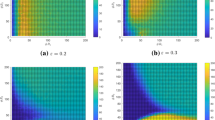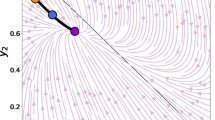Abstract
The aim of this paper is to examine how different types of social influence, introduced on the microscopic (individual) level, manifest on the macroscopic level, i.e. in the society. The inspiration for this task came mainly from two sources—social psychology that recognize two different types of nonconformity (anticonformity and independence) and the observation related to the agent-based modeling that was verbalized in 2002 by Macy and Willer that there was a little effort to provide analysis of how results differ depending on the model designs. To achieve the goal, we propose a generalized model of opinion dynamics, that as a special cases reduces to the linear voter model, Sznajd model, q-voter model and the majority rule. We use the model to examine the differences, that appear at the macroscopic level, under the influence of two types of nonconformity, introduced on the microscopic level. We answer the question if the observed differences are universal or model dependent.












Similar content being viewed by others
References
Macy, M.W., Willer, R.: From factors to actors: computational sociology and agent-based modeling. Annu. Rev. Sociol. 28, 143–166 (2002)
Squazzoni, F.: The impact of agent-based models in the social sciences after 15 years of incursions. Hist. Econ. Ideas XVIII, 197–233 (2010)
Chen, S.: Varieties of agents in agent-based computational economics: a historical and an interdisciplinary perspective. J. Econ. Dyn. Control 36, 1–25 (2012)
Rand, W., Rust, R.T.: Agent-based modeling in marketing: guidelines for rigor. Int. J. Res. Mark. 28, 181–193 (2011)
Kiesling, E., Günther, M., Stummer, Ch., Wakolbinger, L.M.: Agent-based simulation of innovation diffusion: a review. Cent. Eur. J. Oper. Res. 20, 183–230 (2012)
Galam, S., Gefen, Y., Shapir, Y.: Sociophysics: a new approach of sociological collective behavior. I. Mean-behavior description of a strike. J. Math. Sociol. 9, 1–13 (1982)
Galam, S.: Sociophysics: a personal testimony. Physica A 336, 49–55 (2004)
Galam, S.: Sociophysics: A Physicist’s Modeling of Psycho-Political Phenomena. Springer, New York (2012)
Castellano, C., Fortunato, S., Loreto, V.: Statistical physics of social dynamics. Rev. Mod. Phys. 81, 591–646 (2009)
Nyczka, P., Sznajd-Weron, K., Cislo, J.: Phase transitions in the q-voter model with two types of stochastic driving. Phys. Rev. E 86, 011105 (2012)
Martins, A.C.R.: Discrete opinion models as a limit case of the CODA model. arXiv:1201.4565v1
Lewenstein, M., Nowak, A., Latane, B.: Statistical mechanics of social impact. Phys. Rev. A 45, 763–776 (1992)
Hołyst, J.A., Kacperski, K., Schweitzer, F.: Social impact models of opinion dynamics. Ann. Rev. Comput. Phys. 9, 253–273 (2001)
Martins, A.C.R.: Continuous opinions and discrete actions in opinion dynamics problems. Int. J. Mod. Phys. C 19, 617–624 (2008)
Axelrod, R.: The dissemination of culture: a model with local convergence and global polarization. J. Confl. Resolut. 41, 203–226 (1997)
Deffuant, G., Neau, D., Amblard, F., Weisbuch, G.: Mixing beliefs among interacting agents. Adv. Complex Syst. 3, 87–98 (2001)
Hegselmann, R., Krause, U.: Opinion dynamics and bounded confidence: models, analysis and simulation. J. Artif. Soc. Soc. Simul. 5(3) (2002). http://jasss.soc.surrey.ac.uk/5/3/2.html
Liggett, T.M.: Interacting Particle Systems. Springer, Heidelberg (1985)
Krapivsky, P.L., Redner, S., Ben-Naim, E.: A Kinetic View of Statistical Physics. Cambridge University Press, Cambridge (2010)
Galam, S.: Majority rule, hierarchical structures and democratic totalitarianism: a statistical approach. J. Math. Psychol. 30, 426–434 (1986)
Galam, S.: Social paradoxes of majority rule voting and renormalization group. J. Stat. Phys. 61, 943–951 (1990)
Krapivsky, P.L., Redner, S.: Dynamics of majority rule in two-state interacting spin systems. Phys. Rev. Lett. 90, 238701 (2003)
Sznajd-Weron, K., Sznajd, J.: Opinion evolution in closed community. Int. J. Mod. Phys. C 11, 1157–1165 (2000)
Galam, S.: Local dynamics vs. social mechanisms: a unifying frame. Europhys. Lett. 70, 705–711 (2005)
Lambiotte, R., Redner, S.: Dynamics of non-conservative voters. Europhys. Lett. 82, 18007 (2008)
Castellano, C., Muñoz, M.A., Pastor-Satorras, R.: Nonlinear q-voter model. Phys. Rev. E 80, 041129 (2009)
Cialdini, R.B., Goldstein, N.J.: Social influence: conformity and compliance. Annu. Rev. Psychol. 55, 591–621 (2004)
Griskevicius, V., Goldstein, N.J., Mortensen, C.R., Cialdini, R.B., Kenrick, D.T.: Going along versus going alone: when fundamental motives facilitate strategic (non)conformity. J. Pers. Soc. Psychol. 91, 281–294 (2006)
Latane, B.: The psychology of social impact. Am. Psychol. 36, 343–356 (1981)
Asch, S.E.: Opinions and social pressure. Sci. Am. 193, 31–35 (1955)
Pronin, E., Berger, J., Molouki, S.: Alone in a crowd of sheep: asymmetric perceptions of conformity and their roots in an introspection illusion. J. Pers. Soc. Psychol. 92, 585–595 (2007)
Murray, D.R., Trudeau, R., Schaller, M.: On the origins of cultural differences in conformity: four tests of the pathogen prevalence hypothesis. Pers. Soc. Psychol. Bull. 37, 318329 (2011)
Willis, R.H.: Two dimensions of conformity-nonconformity. Sociometry 26, 499–513 (1963)
Willis, R.H.: Conformity, independence, and anticonformity. Hum. Relat. 18, 373–388 (1965)
Nail, P., MacDonald, G., Levy, D.: Proposal of a four-dimensional model of social response. Psychol. Bull. 126, 454–470 (2000)
MacDonald, G., Nail, P.R., Levy, D.A.: Expanding the scope of the social response context model. Basic Appl. Soc. Psychol. 26, 77–92 (2004)
MacDonald, G., Nail, P.R.: Attitude change and the public-private attitude distinction. Br. J. Soc. Psychol. 44, 15–28 (2005)
Nail, P.R., MacDonald, G.: On the development of the social response context model. In: Pratkanis, A. (ed.) The Science of Social Influence: Advances and Future Progress, pp. 193–221. Psychology Press, New York (2007)
Solomon, M.R., Bamossy, G., Askegaard, S., Hogg, M.K.: Consumer Behavior, 3rd edn. Prentice Hall, New York (2006)
Brush, S.G.: History of the Lenz-Ising model. Rev. Mod. Phys. 39, 883–893 (1967)
Niss, M.: History of the Lenz-Ising model 1920–1950: from ferromagnetic to cooperative phenomena. Arch. Hist. Exact Sci. 59, 267–318 (2005)
Niss, M.: History of the Lenz-Ising model 1950–1965: from irrelevance to relevance. Arch. Hist. Exact Sci. 63, 243–287 (2009)
Niss, M.: History of the Lenz-Ising model 1965–1971: the role of a simple model in understanding critical phenomena. Arch. Hist. Exact Sci. 65, 625–658 (2011)
Galam, S.: Fragmentation versus stability in bimodal coalitions. Physica A 230, 174–188 (1996)
Galam, S., Moscovici, S.: Towards a theory of collective phenomena: consensus and attitude changes in groups. Eur. J. Soc. Psychol. 21, 49–74 (1991)
Galam, S.: Rational group decision making: a random field Ising model at T=0. Physica A 238, 66–80 (1997)
Callen, H.B.: Thermodynamics and an Introduction to Thermostatics, 2nd edn. Wiley, New York (1985)
Schelling, T.C.: Dynamic models of segregation. J. Math. Sociol. 1, 143–186 (1971)
Kawasaki, K.: Kinetics of Ising models. In: Domb, C., Green, M.S. (eds.) Phase Transitions and Critical Phenomena, vol. 2, pp. 443–501. Academic Press, San Diego (1972)
Goldenberg, J., Efroni, S.: Using cellular automata modeling of the emergence of innovations. Technol. Forecast. Soc. Change 68, 293–308 (2001)
Goldenberg, J., Libai, B., Muller, E.: Using complex systems analysis to advance marketing theory development: modeling heterogeneity effects on new product growth. Acad. Market. Sci. Rev. 9, 1–18 (2001)
Garber, T., Goldenberg, J., Libai, B., Muller, E.: From density to destiny: using spatial dimension of sales data for early prediction of new product success. Mark. Sci. 23, 419–428 (2004)
Moldovan, S., Goldenberg, J.: Cellular automata modeling of resistance to innovations: effects and solutions. Technol. Forecast. Soc. Change 71, 425–442 (2004)
Wu, F.Y.: The Potts model. Rev. Mod. Phys. 54, 235–268 (1982)
Deffuant, G., Huet, S., Amblard, F.: An individual-based model of innovation diffusion mixing social value and individual benefit. Am. J. Sociol. 110, 1041–1069 (2005)
Thiriot, S., Kant, J.D.: Using associative networks to represent adopters’ beliefs in a multiagent model of innovation diffusion. Adv. Complex Syst. 11, 261–272 (2008)
Kosterlitz, J.M., Thouless, D.J.: Ordering, metastability and phase transitions in two-dimensional systems. J. Phys. C, Solid State Phys. 6, 1181–1203 (1973)
Kosterlitz, J.M.: The critical properties of the two-dimensional xy model. J. Phys. C, Solid State Phys. 7, 1046–1060 (1974)
Flache, A., Macy, M.W.: Small worlds and cultural polarization. J. Math. Sociol. 35, 146–176 (2011)
Deffuant, G., Neau, D., Amblard, F., Weisbuch, G.: Adv. Complex Syst. 3, 87 (2000)
Ashkin, J., Teller, E.: Statistics of two-dimensional lattices with four components. Phys. Rev. 64, 178 (1943)
Sznajd-Weron, K., Sznajd, J.: Who is left, who is right? Physica A 351, 593 (2005)
Mobilia, M.: Does a single zealot affect an infinite group of voters? Phys. Rev. Lett. 91, 028701 (2003)
Galam, S.: Contrarian deterministic effects on opinion dynamics: the hung elections scenario. Physica A 333, 453–460 (2004)
Schneider, J.: The influence of contrarians and opportunists on the stability of a democracy in the Sznajd model. Int. J. Mod. Phys. C 15, 659–674 (2004)
de la Lama, M.S., Lopez, J.M., Wio, H.S.: Spontaneous emergence of contrarian-like behavior in an opinion spreading model. Europhys. Lett. 72, 851–857 (2005)
Galam, S., Jacobs, F.: The role of inflexible minorities in the breaking of democratic opinion dynamics. Physica A 381, 366–376 (2007)
Sznajd-Weron, K., Tabiszewski, M., Timpanaro, A.M.: Phase transition in the Sznajd model with independence. Europhys. Lett. 96, 48002 (2011)
Albert, R., Barabasi, A.L.: Statistical mechanics of complex networks. Rev. Mod. Phys. 74, 47–97 (2002)
Watts, D.J.: The “new” science of networks. Annu. Rev. Sociol. 30, 243–270 (2004)
Dorogovtsev, S.N., Goltsev, A.V., Mendes, J.F.F.: Critical phenomena in complex networks. Rev. Mod. Phys. 80, 1275–1335 (2008)
Merton, R.K.: Social Theory and Social Structure. Free Press, New York (1968)
Conley, D.: You May Ask Yourself: An Introduction to Thinking Like a Sociologist, 2nd edn. Norton, New York (2011)
Sznajd-Weron, K., Weron, R.: A simple model of price formation. Int. J. Mod. Phys. C 13, 115–123 (2002)
Slanina, F., Lavicka, H.: Analytical results for the Sznajd model of opinion formation. Eur. Phys. J. B 35, 279 (2003)
Author information
Authors and Affiliations
Corresponding author
Additional information
The work was supported by funds from the National Science Centre (NCN) through grant no. 2011/01/B/ST3/00727.
Rights and permissions
About this article
Cite this article
Nyczka, P., Sznajd-Weron, K. Anticonformity or Independence?—Insights from Statistical Physics. J Stat Phys 151, 174–202 (2013). https://doi.org/10.1007/s10955-013-0701-4
Received:
Accepted:
Published:
Issue Date:
DOI: https://doi.org/10.1007/s10955-013-0701-4




